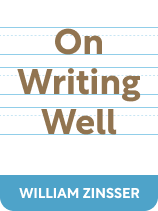

This article is an excerpt from the Shortform book guide to "On Writing Well" by William Zinsser. Shortform has the world's best summaries and analyses of books you should be reading.
Like this article? Sign up for a free trial here .
Are you thinking of reading On Writing Well by William Zinsser? Can the book help you improve your nonfiction writing skills?
No matter your current skill level, William Zinsser believes anyone can practice the craft of writing. On Writing Well offers a back-to-basics approach, focusing on honing essential writing skills rather than trying to employ complex stylistic techniques.
Here’s our On Writing Well review, including the book’s approach, critical reception, and impact.
Book Overview
In On Writing Well, William Zinsser argues that, like any craft, good writing can be learned. Writing is a form of communication, and most of us have to communicate via writing in our lives or jobs. If you want to write an intelligent email, a best-selling novel, or an instruction manual, Zinsser’s principles of writing will help you communicate effectively.
After years of writing professionally and teaching writing courses, Zinsser distilled his main ideas about good writing into On Writing Well. In this guide, we’ll break down Zinsser’s principles of writing: simplicity, clarity, and identity. We’ll also explore his advice on constructing good writing and on common challenges of different nonfiction genres. In addition, we’ll examine how his principles align with or differ from other writing experts, and we’ll explore how his ideas can play out in specific examples.
About the Author
William Zinsser was an American writer, journalist, and teacher. He wrote 19 books, including On Writing Well, Writing to Learn, and Writing About Your Life. He frequently contributed articles to Life and The American Scholar magazine.
Zinsser taught writing classes at Yale University and the Columbia University Graduate School of Journalism. This book distills much of the information he taught in his lectures on creative nonfiction.
After losing his eyesight, Zinsser began one-on-one coaching for aspiring and professional writers. Writers would read him their work, and he’d critique it—for the small price of a sandwich. In 2015, he passed away at the age of 92.
Connect with William Zinsser:
The Book’s Publication
On Writing Well was originally published in 1976 by HarperCollins. The book is now in its 30th edition. In 2004, Zinsser published a book called Writing About Your Life, which expands on his advice on writing memoirs.
Historical Context
Zinsser initially published On Writing Well in response to the popularization of nonfiction as a genre throughout the 20th century. Zinsser explains that World War II exposed people to the harsh realities of life, making Americans more fact-minded. People became disinterested in the slower pace and long-winded descriptions found in fiction novels. This shift was reflected in the popular works of the time, such as Silent Spring (which launched the environmental movement) and In Cold Blood (a true crime story about the murder of a Kansas family). Both books shifted away from the flowery, detailed language of the 19th and early 20th centuries toward a more direct and journalistic style of writing.
Because of this genre shift, demand for both nonfiction writing and writers increased, encouraging new forms of writing, such as blogs and email. Zinsser notes that more people became writers—whether as a profession, hobby, or necessity—and he wanted to share the fundamentals for good nonfiction writing.
After publishing the first edition, Zinsser also frequently updated the book to account for cultural changes and new insights on writing. For example, in response to more women exploring writing in the 20th century, Zinsser updated the book to warn writers against sexist pronoun usage in their writing. As he continued teaching nonfiction courses to students, he learned about new problems writers faced that would be beneficial in On Writing Well. For example, he included a section about enjoying the process of writing, since he noticed his students worrying about the finished product.
Intellectual Context
Zinsser explains that he wrote On Writing Well as a nonfiction-focused follow up to The Elements of Style by William Strunk Jr. and E. B. White. Some of Strunk and White’s elements of style are clarity, conciseness, coherence, unity, correctness (grammar), precision (word choice), and taste (style). Zinsser explores many of these same principles. Zinsser also follows a similar organization to Strunk and White’s structure, discussing usage and various writing forms.
The Book’s Impact
On Writing Well is a popular writing reference for all disciplines of nonfiction. Many readers appreciate the book’s practical advice and back-to-basics approach and have found the book helpful for writers of all skill levels.
Critical Reception
On Writing Well has sold more than 1.5 million copies and is widely regarded as an essential guide for writers. On Writing Well‘s reviews are generally positive. Many writers note that the book is one of the best references for nonfiction writing, and they cite Zinsser’s advice to simplify writing and eliminate clutter as particularly helpful. Reviewers agree that On Writing Well is most effective as a general guide to writing, rather than as a comprehensive guide to learning specific techniques such as humor or grammar rules.
Commentary on the Book’s Approach
Zinsser follows his own advice and writes with simplicity and clarity, making his writing accessible and enjoyable to read. He describes important elements of writing using his own writing background, examining work from other good writers, and discussing his experiences teaching students how to write.
Zinsser also takes a conversational approach to discussing writing. He doesn’t talk down to writers, taking the role of a supportive mentor or professor instead. He describes a back-to-basics approach, which focuses on honing essential skills rather than trying to employ complex stylistic techniques.
Commentary on the Book’s Organization
Zinsser organizes his book into four main sections: Principles, Methods, Forms, and Attitudes. The first discusses general concepts of writing, such as simplicity and style. The second part discusses specific pieces of advice, such as the functions of different word types. The third part explores the different types of nonfiction writing and the common problems writers encounter in those genres. The final section discusses a writer’s identity, how to approach writing, and creative decisions.

———End of Preview———
Like what you just read? Read the rest of the world's best book summary and analysis of William Zinsser's "On Writing Well" at Shortform .
Here's what you'll find in our full On Writing Well summary :
- A back-to-basics approach to the craft of writing
- How to practice simple, clear, and engaging writing—even if you're not a writer
- How to effectively put your ideas into words






